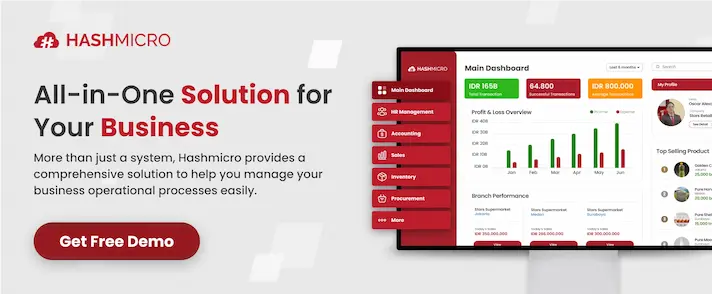Let’s say you display new items in your display window. A few days later, it turns out the goods sell well and orders sky-rocketed. On the other hand, your supply running low and you start to panic because orders keep on coming. You will not end up panicking if you calculate the reorder point correctly.
With precise reorder point calculation, you don’t need to worry about goods piling up in the warehouse because you ordered too much, or see the customer sad faces because they can’t buy the things they’re looking for.
Reorder point will make your purchasing system run smoothly without having to experience these worries. In this article, we will discuss what a reorder point is, and how to calculate it properly.
Key Takeaways
|

What is a Reorder Point
A reorder point is the moment at which an item in a warehouse management system must be purchased before it runs out of stock. The important question is; “when is the right time to order the items?”
Novice retailers only rely on their guts when it comes to reordering. When they saw increased demand, they begin to stock up items in the warehouse. On the other hand, when the demand is low, they avoid purchasing stuff.
For those with experiences, they stock up to anticipate high seasons such as Christmas and New Year. In principle, it doesn’t matter if they run out of stock only if they reached the sales quota.
There is an appropriate way to know when the right time to place an order, which is calculating reorder point with the correct formula.
Related article:
- 7 Best Inventory Control Tips to Improve Efficiency
- This is How Stock Inventory Management Save Your Expenses
How to Calculate Reorder Points
There are three main parameters in the reorder points calculation:
Lead Time demand (in days) + Safety Stock (in days) = Reorder Points
For more details, let’s discuss these parameters one by one.
Lead time demand
In a sense, a lead time is the time gap between ordering an item until it arrives at your front door, which directly affects the reorder level in inventory management. Industry or business lead times can range from a few weeks to several months.
The length of lead time depends on the manufacturing difficulty, the order amount, and the distance traveled. If your suppliers are from Russia, and your order thousands of items, do not expect your order will arrive tomorrow or the day after!
To make it easier to understand, consider the following illustration. Let’s say you sell leather wallets imported from China. Supposedly, your supplier has never experienced problems with stock level and ready to ship those wallets at a moment notice. But they need two days to pick and pack the items. After that, your wallets spend another five days inside a truck to the port. From the port, your order sails on a cargo ship in the Pacific Ocean from China to Singapore for another 30 days. At the port, your wallets must be inspected by the customs that usually takes a week, then sent by a courier to you which will take around 5 days journey.
Total lead time: 2 + 5 + 30 + 7 + 5 = 49 days
This data reveals that you must stock enough leather wallets for your customer until the next shipment arrives. You also have to anticipate the increasing demand for the items. Make sure you don’t run out of stock before your order arrives.
Luckily, there is a way to calculate the increasing demand. You only have to multiply the lead time number with average sales per day. Let’s say you sell 10 leather wallets per day, then your business demand lead time is:
Lead Time Demand = Lead Time x Average Sales per Day
49 x 10 = 490
This means you must provide 490 leather wallets to cover sales until the next batch of wallets is in your hands. Sadly, this calculation can only work if nothing unexpected happens. That’s why you need to have a safety stock, as anticipation.
Safety stock – in anticipation
In inventory management, you must anticipate the worst that might occur and potentially disrupt your inventory. For example, some artists suddenly endorse your leather wallet and that make your order number escalated quickly, or a cyclone that suddenly blows into China mainland and disrupts your shipment.
These unexpected factors must be taken into account by preparing safety stock. The problem is, how much do you have to prepare? Don’t you worry, because there’s a formula for it:
Safety stock = (Highest Daily Sales x Longest Lead Time) – (Average Daily Sales x Average Lead Time)
From the previous data, we already know that you managed to sell approximately 10 leather wallet per day, but on Saturday the number of sales goes up to 20 per day. For the lead time, your leather wallet shipment from China usually takes 49 days. However, an accident happens. The truck that delivering your wallets to the port in China got hit by another truck and the delivery delayed up to 54 days.
If entered those numbers into the formula, we will get the safety stock number:
(20 x 54) – (49 x 10) = 590
This means you have to prepare 590 leather wallets as a safety stock to anticipate the unexpected. This will make you still able to sell beautiful wallets to your customers, with no worries whatsoever.
With these results, we can finally get the reorder point value by adding up the lead time demand and the safety stock.
490 (lead time demand) + 590 (safety stock) = 1080 (reorder point)
This means you have to start ordering from your suppliers if the remaining leather wallet in your inventory reaches 1080. This will ensure that your supply of leather wallets will be sufficient until your next order arrives, or if a disaster occurs or unexpected things happens, you still have sufficient inventory and continue selling without worry.
Conclusion

Calculating reorder points is important in inventory management. The thing is, it’s difficult to predict unexpected things such as disasters or accidents. If a condition requires you to update the amount of the safety stock, usually you update it manually.
This hassle can be avoided by using an inventory management system. If you change the safety stock number or lead time demand due to the increasing orders, the system can help you calculate it automatically. You won’t have to worry about the low stock and losing your customers. Schedule a free demo now to experience the transformational power it brings to your operations.
Warning: Undefined array key "med" in /home/hashmicr/public_html/blog/wp-content/plugins/insert-headers-and-footers/includes/class-wpcode-snippet-execute.php(419) : eval()'d code on line 281

Other Articles:
Top Inventory Management Software Systems in Singapore













